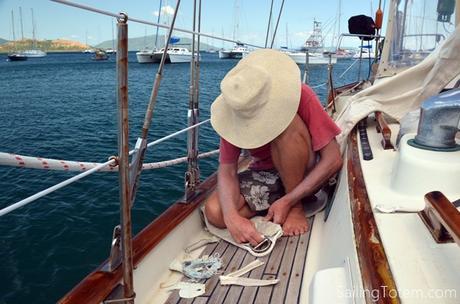

This post comes from Jamie, one in a series where he shares his knowledge as a tenured sailmaker. For more about Jamie’s experience in the field, see Sailmaker SAYS!. Pictured above, Jamie replaced a corroded headboard with a ring on the mainsail of Solstice in Madagascar last year.
Why does the head of a mainsail have a headboard? Because that’s how it’s always been, for racing mainsails; and by default everyone else. Does that make sense for non-racing applications?
Grey MattersHeadboard: triangular-ish plates fastened to mainsail head to provide a stout halyard attachment point and rigid structure to enable greater head width. A typical headboard consists of an aluminum plate on each side of the head, riveted together through the sail. Webbing straps through headboard and sewn to sail provides additional strength.Head ring: round ring attached to mainsail head by webbing straps. Head ring is stainless steel, and often with a bar welded across the middle to increase strength.E (rig dimensions): distance along the boom, from aft face of mast that defines the maximum allowable foot length.
The wider the headboard is, the bigger boost to sail area and sailing performance. Consider that by using a head ring instead of a headboard, head width is an anemic 2” to 3” (50mm to 75mm). Rivet a jumbo aluminum headboard on instead and you push head width up to an astonishing 5” to 7” (127mm to 178mm). That equates to a sail area increase, rounded to the nearest whole number, of 0%. Wait, what?
Really. A headboard adds a sliver of a triangle extending from the head to the top batten. I’ve had bigger splinters! So why is the headboard so small, and can it be made bigger?
Yeah, no. If cruising, your sail doesn’t have to comply with any race rating system, but your backstay is probably a limiting factor. Or if it isn’t and you can have a square top main like bad ass racers…. It adds complexity, higher rig loads, and demands a greater emphasis on depowering the main at the right time. Depowering with each gust, ha! You struggle to find the energy to reef when it’s blowing 30! True that.
So keeping it simple, cruising mains tend to have a standardized width headboard, roughly equal to E x 4%. A foot length (E) of 15’ (4.56m) results in headboard 5.8” (182mm) wide and adjusted to a standard 5.25” (158mm) headboard size. It’ll clear the backstay and look flashy anodized in dingy gold color.
If size doesn’t add meaningful sail area, or performance, surely there are other benefits?
Yeah, no. Again.
Cheaper? No. Stronger? No.. Tougher? No… Lighter? No! Easier for the sailmaker to install? Ah, good questions. No.
Sexier? Really? Just no.
Stupid sailmakers… So, no real benefit okay. Fine. Let’s flip this – any benefit to having a head ring instead of a headboard?
Yes, duh, obviously. Well, sort of.
Uh ha…
It’s like this. There is no performance winner between a head ring and headboard. Neither is one more notably robust than the other. Aluminum headboards and their securing rivets can corrode, but it takes a long time. Webbing stitching securing a head ring, and sometimes headboard, can suffer UV damage. If the sail is always covered when not in use then it takes a long time to damage stitching. And if the webbing is sewn with Tenara thread, UV will never be a problem. No clear choice here.
One point distinguishes a head ring as the better choice for cruising sails. It’s the smooth round ring is so much easier to the mainsail cover, and mast, than the strait, sharp-edge that is the top of a headboard. Your mainsail spends most of its time under mainsail cover being protected from a bombardment of UV rays and bird shit. That’s 3,000 hours of UV and countless bird bombing runs per year. Why shorten the cover life with a headboard that will wear on the cloth and zipper? I’ve also seen masts with scratches and worn areas from headboards. When the mainsail is trimmed very far out, depending somewhat on the type of luff hardware, the headboard can wear against the mast.
This isn’t a compass spinning revelation, but details make a difference for the long haul. So if you’re investing in a new cruising mainsail, consider overlooking the fathead racing mentality and opt for a stainless ring instead.
Even if I have in-mast furling main?
Incoming pelican! RUN!
Jamie’s always happy to answer questions about sails; just comment here or submit our contact form to get a message through, where ever we are. And hey, where is Totem? Find our current position and speed here!

